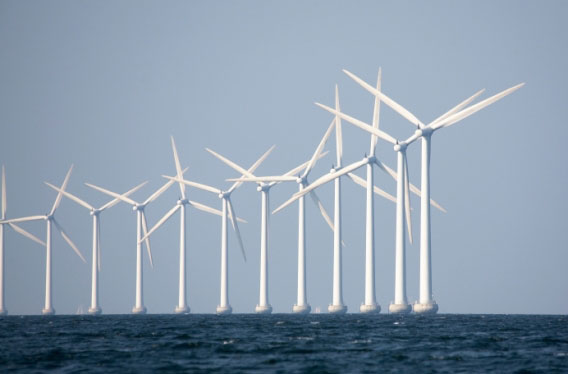Wind Power Arising
Tufts engineers are studying ways to locate and build offshore wind turbines for maximum energy output while keeping costs down
By Marjorie Howard
You can fly into Copenhagen and look down at the sparkling coastline and see hundreds of tall, white structures: offshore wind turbines, their arms spinning like pinwheels. Images like these inspire Lewis Edgers, a professor in the department of civil and environmental engineering, who has long been fascinated by wind and by its potential as a sustainable source of energy.

Tufts engineering faculty are collaborating to help the United States catch up with Europe, where offshore wind turbines are common, such as these along the coast of Denmark near Copenhagen. Photo: iStock
Now he and several Tufts colleagues have begun a collaboration they hope will help the United States catch up with Europe, where offshore turbines are common along the coasts of the Netherlands, Denmark, Britain and Germany.
The purpose of the partnership, says Edgers, is to develop a methodology for siting offshore wind farms to maximize their energy output while minimizing construction and operating costs.
“The U.S. offshore wind industry is in its infancy,” he says. “There are great unknowns in trying to understand how the towers and foundations respond to ocean currents.” The advantage to building wind farms offshore as opposed to on land, he says, is that the winds are steadier, stronger and less turbulent.
Edgers and four other faculty members from his department have received a grant from the Peter (E83) and Denise Wittich Family Fund for Alternative Energy Research. The fund supports work that will lead to the discovery of new, more sustainable ways of producing and using energy. The grant is a starting point for the collaboration, which will need additional funding.
First, the group will develop statistical tools for describing offshore wind. “What that means,” Edgers says, “is that we access worldwide databases on wind, some from airports, but most from ocean buoys and satellite observations, and we analyze those to determine the best places to put a wind turbine.” They have already analyzed a wealth of ocean wind data from 178 buoys, using recent innovations from hydrology and statistics, and found that the traditional models which are used to describe the frequency and magnitude of wind speeds are not entirely accurate over broad ocean environments.
Next the group will develop tools to design the towers and foundations of the turbines and analyze their response to ocean waves and currents. Finally, the group will develop a way to estimate costs.
“Offshore wind farms are more expensive to build than onshore wind farms,” says Edgers. “The farther away from the population that uses the energy, the more expensive they are to build, and the more expensive it is to distribute that energy. We want to be able to minimize those costs so the entire system is most efficient.”
Joining Edgers are Associate Professor Laurie Baise, a geotechnical engineer who brings expertise in understanding wind measurements; Professor Richard Vogel, a hydrologist whose area is probability and statistics; Associate Professor Luis Dorfman, who studies structural mechanics and how materials behave; Eric Hines, a professor of the practice, who specializes in structural design; and Matthew Lackner, an assistant professor at the University of Massachusetts at Amherst, whose expertise is in wind and wind power.
In the Eye of the Beholder
Edgers focuses on geoengineering, particularly the design of the foundations. He hopes to apply what has been learned about offshore oil platforms to wind turbines. Edgers has long had a connection with the Norwegian Geotechnical Institute, which is known for its global expertise in offshore engineering, acquired through working with the oil industry in the North Sea.
“Norway is interested in developing its offshore wind as a renewable energy source, so they are trying to adapt their technology from oil to wind,” says Edgers.
Edgers says his own interest in wind energy came about because one of his students did an internship with a company developing a proposal for offshore wind. In fact, he says, “there’s a tremendous interest among students fascinated by wind power.” Next year, Edgers says, he will involve several undergraduates in the offshore wind collaboration.
He says his group is looking at turbines from the perspective of science and engineering, but there are also many policy and financial issues and environmental concerns to consider, including the possibility of killing birds, which are known to fly into the turbines.
“The turbines are very dramatic,” he says, “not the kind of thing you want in a heavily populated area. Most people don’t see the beauty in them; only an engineer would.” Edgers smiles. “I think they’re magnificent.”
Marjorie Howard can be reached at marjorie.howard@tufts.edu.

